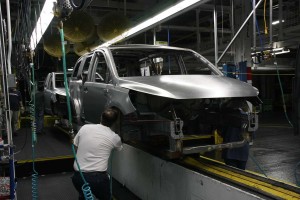
Despite deep cuts in both production capacity and the number of models offered by makers, such as Chrysler -- workers shown here building the Town & Country minivan -- a new study warns that the U.S. market remains dangerously over-crowded.
With the U.S. automaker off by nearly half since it hit its stride, earlier in the decade, manufacturers have been slashing their production and sharply reducing production. The hardest makers, Detroit’s Big Three, have or will close more than a score of plants and trimmed their overall workforces by roughly half. But even the most successful makers, like Toyota and Honda, are making unanticipated cutbacks. Yet this may not be enough in the face of the weakening market.
The U.S. car market remains overcrowded, with too many manufacturers and too many nameplates, warns a new study by the consulting firm, A.T. Kearney. Daniel Cheng, director of the firm’s automotive practice, said the situation could still get worse over the next few years as Chinese manufacturers begin to edge into the U.S. market.
“Six companies now aspire to be full line generalists,” like Ford Motor Co., Toyota Motor Co., and General Motors, Cheng noted, during a Thursday presentation to TheDetroitBureau.com and other members of the automotive media.
 “The U.S. market is incredibly crowded,” Cheng added, contending that none of the major manufacturers, even those in bankruptcy, appear prepared to step back from the competitive fight. But, as a result, the full-line manufacturers, including Honda and Nissan, now offer too many nameplates in the U.S. market for them to earn a profit and be sustainable.
“The U.S. market is incredibly crowded,” Cheng added, contending that none of the major manufacturers, even those in bankruptcy, appear prepared to step back from the competitive fight. But, as a result, the full-line manufacturers, including Honda and Nissan, now offer too many nameplates in the U.S. market for them to earn a profit and be sustainable.
“The number of nameplates offered for sale in the U.S. would need to shrink by one-third — from the current 336 to 214 — to maintain a sustainable margin in 2009,” the study found.
Even with the elimination of brands like Pontiac, and the overall reduction in models at the Big Three, and even with a rebound in sales volumes to the 16-million-unit level, by 2014, A.T. Kearney concluded that full-line OEMs would need to eliminate another 32 nameplates currently on their books in order to earn a sustainable margin.
In addition, government action also complicates the situation, the study argues. “There has been a significant level of intervention, which distorts the market,” Cheng said.
Cheng said the crowed nature of the market will also make it harder for manufacturers to take advantage of the increase in sales volume, which should begin to show up next year.
“Auto sales are driven by four macroeconomic factors,” said Cheng. Although the firm predicts U.S. auto sales will contract an additional 24 percent to 10 million in 2009, it forecasts that they will return to 16 million units, by 2012, under the most likely of three scenarios it reviewed.
Based on some 35 years of light-vehicle sales data, the study found that while auto sales rates fall precipitously during recessionary periods, there exists a specific level of “pent-up demand” which helps sales spring back rapidly, once a recovery begins. Based on the firm’s current forecast, A.T. Kearney expects 8.4 million units of pent-up demand to materialize through 2015.
The volatility of the market creates a variety of uncertainties, Cheng cautioned, such as the possibility that failing suppliers could cripple, even break the back of some automakers.
“Recovery will ultimately come down to how quickly the economy improves,” he concluded, “and I’m sure the government will be doing everything it can to help the industry avoid the worst case scenario outlined in our report.”
